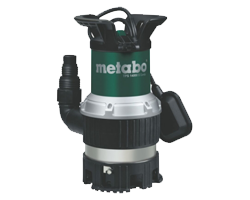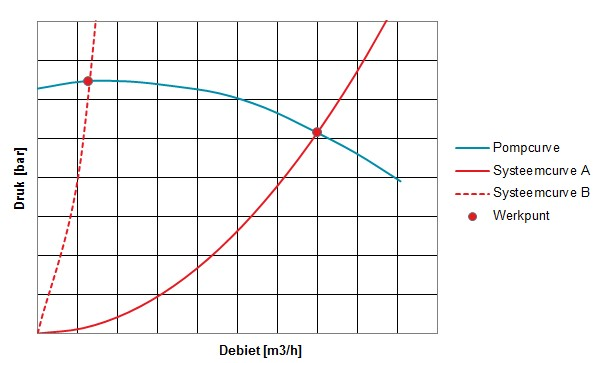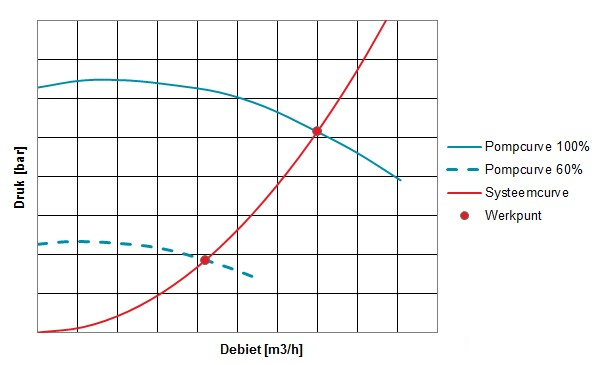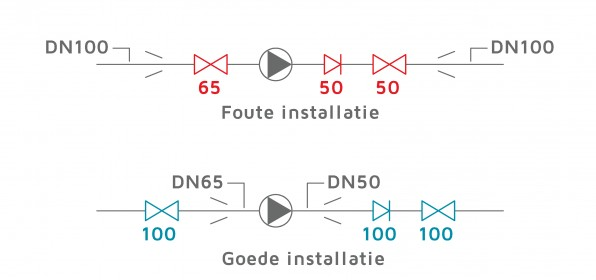
Optimising pump systems:
Tips and tricks
Various engineering consultancies and manufacturers have analysed pump installations. Their analysis has shown that there is
a range of possible improvements that could result in energy consumption being reduced by 70%.
The investment required for some modifications can be recouped within a short period of time, whereas other options are only
worthwhile if pumps need replacing or if the installation is being built from scratch. I have listed a number of popular savings
opportunities and focus points below.

Small pumps assortment
Discover the full range of pumps in the ERIKS webshop and find the right product for your application.
View the range
Pump selection
Pump curve
The figure below shows a pump curve. This curve indicates the relationship between the discharge head and the flow rate. It is important to know the system properties so that you can select the correct pump. The properties indicate the relationship between the flow rate through the system and the pressure drop in the system (static and dynamic).
The value at which the system curve and pump curve intersect is the operating point of the pump. It is important that the operating point lies within the pump's range of application. If the value lies too far to the left or the right, this will have an adverse effect on the service life of the pump. It is therefore preferable to select a pump that is as close as possible to the Best Efficiency Point (BEP), as demonstrated by system curve A in the figure below.

If the operating point lies too far to the left or the right on the pump curve (see system curve B in the figure), the pump is operating outside of its range of application. This results in poor pump efficiency. In addition, the pump will be subjected to an inappropriate load, resulting in a shorter service life.
Determining the system properties is therefore a crucial step when selecting a pump. Studies have shown that for many pumps, the operating point deviates significantly from the pump's optimal range of application. In addition to consuming a greater amount of energy, the pump is subject to a greater amount of wear and has a shorter service life.
Electric motor
Pumps are driven by an electric motor. In addition to knowing the efficiency class, it is important to be aware that the efficiency of an electric motor can be reduced, particularly when operating with a partial load. The efficiency of a motor is indicated by its IE class. When replacing a pump, it is both advisable and cost-effective to replace the electric motor with one belonging to the highest possible IE class.
Pump efficiency
As with an electric motor, a pump also features a certain level of efficiency. Selecting the right pump with the perfect combination of pump housing and impeller diameter can result in a significant energy saving and will ensure that the pump operates under the optimum load, thereby providing the best possible service life.
Control
There are various methods of controlling a pump system, and selecting the correct control method can save energy. Fine-tuning sensors is another method that often results in an energy saving.
Speed regulation
A number of systems are fitted with regulating discs that are able to influence the flow of water. A regulating disc provides resistance and effectively kills energy. By using a frequency converter, you can control the capacity of the pump so that the same effect is achieved while using less energy.
Controlling the pump speed adjusts the pump curve, thereby shifting the operating point along the system curve. As a result, the capacity of the pump can be adapted to changes in the system. This is shown in the figure below.

When adjusting a speed regulator, it is important that the system curve and the pump curve are properly aligned, both at full load and at partial load.
Setpoint
Many pumps that feature a speed regulator can be regulated on the basis of a fixed pressure or fixed pressure differential. The simplest way of achieving a saving is by lowering the setpoint where possible. Another option is to use a dynamic pressure regulator, where the pressure setpoint is adapted to the required flow rate. This can be achieved by using a SCADA system, for example.
Master/slave
Many systems feature multiple pumps arranged in parallel and are equipped with on/off regulation or speed regulation. By mapping out the pump properties both individually and collectively, an intelligent start-up strategy can be defined in which only the most efficient combination of pumps and speeds is used.
System
Every system is unique, and opting for the correct system design can save a considerable amount of pump energy. Some focus points to consider when designing a system are:
Pipework diameter: The choice of pipework diameter affects the flow rate and resistance (pressure drop) in a system and therefore the required pump energy. A narrower pipework diameter is frequently chosen to save on installation costs.
However, this results in high energy consumption throughout the entire service life of the pump installation. Opting for slightly wider dimensions when designing pipe systems will save pump energy throughout the entire service life of the installation, therefore the higher installation costs will be more than recouped in no time at all.
Overflow: Many installations feature regulating valves or pressure-regulating discs to maintain a minimum flow rate in the system as long as there is no decrease. If there is too much overflow, the system continuously pumps superfluous water and consumes energy. It is therefore essential that such valves are adjusted correctly.
Fittings upstream and downstream of the pump: The suction and pressure connections on a pump are usually smaller than the pipework diameter required, therefore an adapter or reducer is required. A common mistake is installing the fittings between the reducer and the pump.
The small diameter makes the fittings cheaper; however, the high speed at which liquid flows through the fittings results in a greater pressure drop (low kV value). This increased drop in pressure leads to additional energy being consumed by the pump. This is shown in the figure below.

Installing the fittings in the section of the pipework with the larger diameter increases the investment cost of the fittings. However, this is quickly recouped by the reduced energy consumption.
If you have any questions about pumps, pump optimisation or energy saving, get in touch with our
product specialists. Call us on 0800 854 817 or send us an email.







